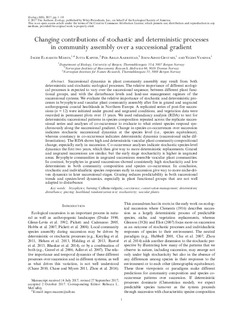Changing contributions of stochastic and deterministic processes in community assembly over a successional gradient
Journal article, Peer reviewed
Published version

View/
Date
2017Metadata
Show full item recordCollections
- Publikasjoner fra CRIStin - NINA [2364]
- Scientific publications [1392]
Original version
10.1002/ecy.2052/suppinfoAbstract
Successional dynamics in plant community assembly may result from both deterministic and stochastic ecological processes. The relative importance of different ecological processes is expected to vary over the successional sequence, between different plant functional groups, and with the disturbance levels and land-use management regimes of the successional systems. We evaluate the relative importance of stochastic and deterministic processes in bryophyte and vascular plant community assembly after fire in grazed and ungrazed anthropogenic coastal heathlands in Northern Europe. A replicated series of post-fire successions (n = 12) were initiated under grazed and ungrazed conditions, and vegetation data were recorded in permanent plots over 13 years. We used redundancy analysis (RDA) to test for deterministic successional patterns in species composition repeated across the replicate successional series and analyses of co-occurrence to evaluate to what extent species respond synchronously along the successional gradient. Change in species co-occurrences over succession indicates stochastic successional dynamics at the species level (i.e., species equivalence), whereas constancy in co-occurrence indicates deterministic dynamics (successional niche differentiation). The RDA shows high and deterministic vascular plant community compositional change, especially early in succession. Co-occurrence analyses indicate stochastic species-level dynamics the first two years, which then give way to more deterministic replacements. Grazed and ungrazed successions are similar, but the early stage stochasticity is higher in ungrazed areas. Bryophyte communities in ungrazed successions resemble vascular plant communities. In contrast, bryophytes in grazed successions showed consistently high stochasticity and low determinism in both community composition and species co-occurrence. In conclusion, stochastic and individualistic species responses early in succession give way to more niche-driven dynamics in later successional stages. Grazing reduces predictability in both successional trends and species-level dynamics, especially in plant functional groups that are not well adapted to disturbance. bryophytes; burning; Calluna vulgaris; coexistence; conservation management; determinism; disturbance; grazing; heathland; randomization test; stochasticity; vascular plants.
